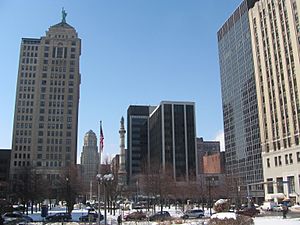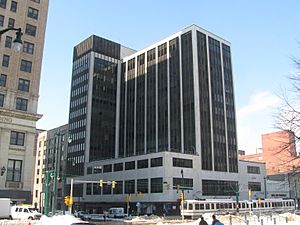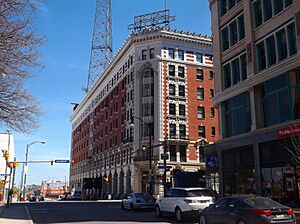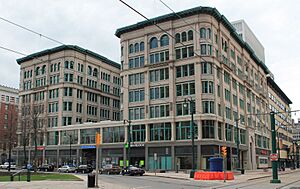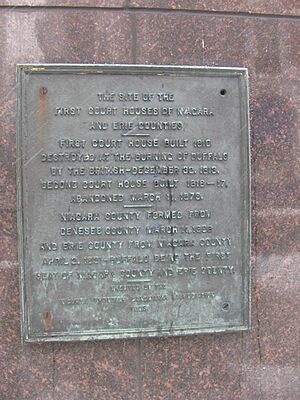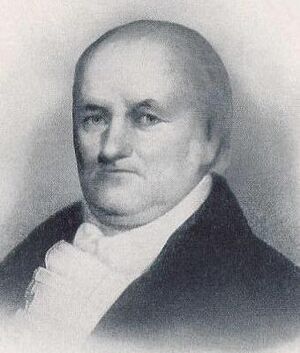Lafayette Square (Buffalo) facts for kids
Quick facts for kids Lafayette Square |
|
|---|---|
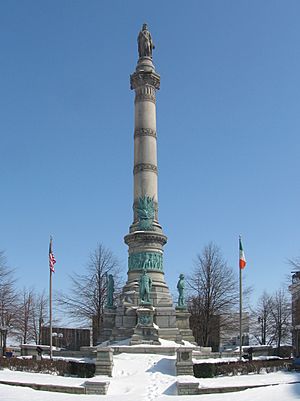
Soldiers and Sailors, the monument at Lafayette Square
|
|
| Type | Public park/Town Square |
| Location | Buffalo, New York |
| Area | 1 city block |
| Created | early 1800s |
| Operated by | City of Buffalo |
| Status | Open all year |
| Public transit access | Lafayette Square (Metro Rail) |
Lafayette Square is a historic park in the heart of downtown Buffalo, Erie County, New York. It was once known as Court House Park or Courthouse Square. This important city block is surrounded by some of Buffalo's tallest buildings. The square was named after General Lafayette, a French hero of the American Revolutionary War, who visited Buffalo in 1825.
Lafayette Square was part of the first plan for Buffalo, created by Joseph Ellicott in 1804. Important government buildings have always been on its eastern side. These include the first Erie County Courthouse and the original Buffalo & Erie County Public Library. Famous moments in American history happened here. For example, Martin Van Buren, a former President of the United States, was nominated for president by the Free Soil Party in 1848. Also, President-elect Abraham Lincoln gave a speech in the square.
Today, you can see Buffalo City Hall, a beautiful Art Deco building, from the square. A large granite monument called Soldiers and Sailors stands tall in the center. This monument honors those who fought in the American Civil War. It was dedicated with a ceremony attended by Grover Cleveland, who later became president. For many years, Lafayette Square hosted summer concerts called Thursday at the Square. It is still a place where people gather for rallies and demonstrations.
Contents
Exploring Lafayette Square's Location
Lafayette Square is one of three main squares designed in Joseph Ellicott's original city plan for Buffalo. It is located three blocks east of Niagara Square and is the second most important public space downtown.
The square is surrounded by busy streets. To the west, the Niagara Frontier Transportation Authority's Metro Rail runs above ground along Main Street. This area is known as the Free Fare Zone, where you can ride the train for free. Washington Street is to the east. Lafayette Square itself forms one-way streets to the north (going west) and south (going east).
Buildings Around the Square
Many important buildings stand around Lafayette Square. These include the Liberty Building, the Main Court Building, 10 Lafayette Square, the Rand Building, and the Buffalo & Erie County Public Library.
On the south side of the square, there are two historic buildings. The Lafayette Hotel was designed by Louise Blanchard Bethune in 1904. The Brisbane Building was built in 1894–95.
Getting Around Lafayette Square
Lafayette Square is easy to reach by public transport. Several Metro Bus routes serve the area. The Lafayette Square Metro Rail station is also right there. In 2003, Lafayette Square became the first place in Buffalo to offer free public Wi-Fi.
Design and Features of the Square
Lafayette Square has changed its look over the years. It used to have an iron fence around it, but that was gone by 1905. In the 1860s, it was a park with many trees. However, by 1876-77, some trees along Main Street were removed.
How the Square's Shape Changed
The square was once a true park, but as downtown Buffalo grew, more space was needed for cars. City planners thought the park was blocking traffic. In 1912, the Buffalo Common Council decided to extend Broadway through Lafayette Square. This made the square much smaller, leaving only a small circle around the Soldiers and Sailors Monument.
Since then, the square has been redesigned a few times. It is now more of a busy intersection than a quiet park. By 1920, cars drove in a circle around the monument, which was surrounded by sidewalks and grass.
The Soldiers and Sailors Monument
The monument in the center of the square is very impressive. It has a tall shaft that holds a 10-foot, 6-inch (about 3.2 meters) female figure at the top. This figure represents the Union during the Civil War.
Around the base of the shaft, there are four 8-foot (about 2.4 meters) bronze statues. These statues, sculpted by Caspar Buberl, represent different parts of the army: the infantry (foot soldiers), artillery (cannons), cavalry (soldiers on horseback), and navy (sailors). They face the four main directions.
Above the statues, bronze pictures carved into the stone show scenes from the war. The dedication on the west side of the monument honors those who died "in the war to maintain the union for the cause of their country and of mankind." Half of Abraham Lincoln's famous Gettysburg Address is carved on the east side. Other panels show members of Lincoln's original cabinet, like William H. Seward (Secretary of State).
History of Lafayette Square
Long ago, a small stream flowed from Lafayette Square down Court Street. The square was home to the Niagara County Courthouse from 1810 until it was destroyed by the British Army during the War of 1812 in 1813. In 1831, the Holland Land Company gave the land for the park to the city.
Early Buildings and Events
The first Erie County Courthouse was built facing the square in 1818. Buffalo became the county seat of Erie County in 1821. A jail was added behind the courthouse in 1833. In 1853, the city put a fence around the square and added a fountain.
President-elect Abraham Lincoln spoke at the square on February 16, 1861. The courthouse was used until 1876.
A new Buffalo & Erie County Public Library building was built on the courthouse site in 1887. This building was replaced by the current library building between 1961 and 1963. The first library building was known for its amazing gargoyles, but they were not saved when the building was torn down.
Famous Visitors and Political Gatherings
In 1825, General Lafayette visited the square during his famous tour of the United States. He gave a speech on June 4, celebrating 50 years since the start of the American Revolutionary War. The square also hosted many public meetings and early Erie County Fairs.
In 1848, the Free Soil Party held its national meeting in Buffalo. This party later joined the Republican Party. At this meeting, they chose Martin Van Buren, a former U.S. President, as their candidate for president. Forty thousand people watched this event at the square! Other famous speakers like Henry Clay and Daniel Webster also spoke here.
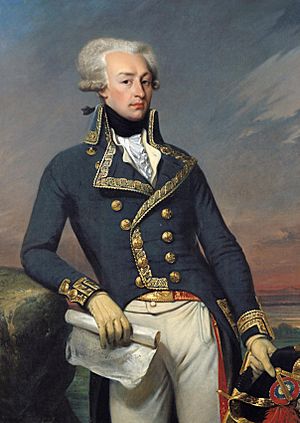
Building the Civil War Monument
The idea for a Civil War monument started in 1866. But it wasn't until 1874 that Mrs. Horatio Seymour organized the Ladies Union Monument Association. This group raised $12,000 for the project. The city of Buffalo then added another $45,000. In 1879, the square's name was officially changed from Court House Park to Lafayette Square.
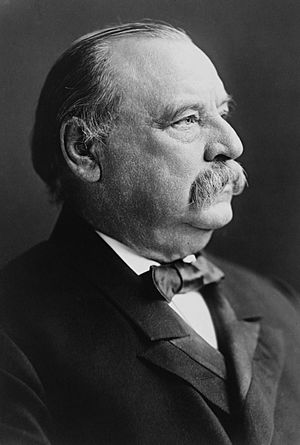
Grover Cleveland, who was then the Mayor of Buffalo, laid the first stone for the 85-foot (about 26 meters) granite Soldiers and Sailors monument on July 4, 1882. He returned as the Governor of New York to dedicate the monument on July 4, 1884. A time capsule was sealed away during the first ceremony. Many important people, including other governors and generals, attended the dedication.
Saving the Monument
The monument has faced challenges over time. In 1889, its foundation began to sink unevenly, making it tilt like the Tower of Pisa. The monument had to be taken apart and rebuilt with a stronger base. Also, the time capsule was found to be damaged.
Later, in 1973, a car crashed into the monument. Some people wanted to tear it down. But thanks to fundraising efforts by the Buffalo Civil War Round Table, the monument was repaired and saved.
Lafayette Square Today
From 1986 to 2011, Lafayette Square was home to the "Thursday at the Square" concert series. These free concerts featured many different types of music. In 2012, the concert series moved to the Buffalo inner harbor and was renamed "Thursday at Canalside."
Because of its central location, Lafayette Square is often chosen for rallies and demonstrations. For example, after the Buffalo Bills lost Super Bowl XXV, fans gathered at the square to show their support for the team. The square continues to be a place where people come together to express their views.
Images for kids
-
View from Niagara Square to Lafayette Square from City Hall in a snow flurry.
See also
 In Spanish: Plaza Lafayette (Búfalo) para niños
In Spanish: Plaza Lafayette (Búfalo) para niños


